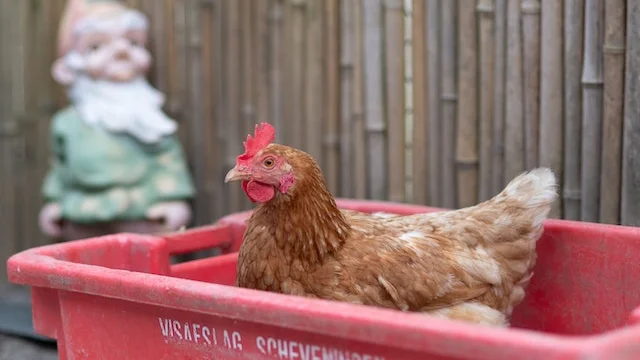Bird flu has reappeared in US commercial poultry flocks, raising concerns about the potential for more outbreaks. The highly pathogenic avian influenza was confirmed in turkey farms in South Dakota and Utah, marking the first reported cases among commercial flocks since April.
The virus, which is deadly to poultry, led to the destruction of infected flocks and costly decontamination efforts. Last year’s bird flu outbreak was the deadliest in US history, impacting nearly 59 million birds across the country. While infections in humans are rare, experts worry about the virus evolving to spread more easily among people. Strict biosecurity measures are being urged to prevent the virus from spreading further.
Background
Introduction
Deadly bird flu has reappeared in commercial poultry flocks in the United States, causing concerns about the potential for more outbreaks. The highly pathogenic avian influenza has already affected turkey farms in South Dakota and Utah.
This article will explore the impact of the current outbreak on the poultry industry, the concerns about the spread of the virus to humans, and the comparisons to previous outbreaks. It will also discuss the potential for more cases, the risk to humans, the connection to Europe, and the biosecurity measures being taken. Finally, it will examine the impact on South Dakota and Iowa and conclude with an overview of the current situation.
Previous Outbreaks
In recent years, the United States has experienced outbreaks of bird flu that have had a significant impact on the poultry industry. The most recent outbreak occurred in 2022, resulting in the loss of nearly 59 million birds across 47 states.
This made it the deadliest outbreak ever recorded in the country. The outbreak also led to increased prices for eggs and turkey, affecting consumers. In 2015, there was another outbreak that caused the loss of nearly 51 million birds in 15 states, making it the most expensive animal health disaster in U.S. history.
Impact on Poultry Industry
The current outbreak of bird flu has already had a significant impact on the poultry industry, with two confirmed cases in turkey farms in South Dakota and Utah. Infected flocks are typically destroyed to prevent the spread of the disease, resulting in losses for producers.
The outbreaks are a cause for concern for the industry, as they suggest that more cases could follow. The migration of birds is a factor that contributes to the spread of avian influenza, making it difficult to contain the virus.
Concerns about Spread to Humans
Although bird flu infections in humans are relatively rare, there are concerns about the potential for the virus to evolve and spread more easily among people. The recent case in Cambodia, where a human death was reported, highlights these concerns.
While the virus primarily affects birds, it can also infect other species, including some mammals. Scientists are monitoring the virus closely to understand its potential for evolution and its impact on human health.
Current Outbreak
Affected Poultry Farms
So far, the current outbreak has affected one turkey farm in South Dakota and one in Utah. The infected flocks have been confirmed to have the deadly avian influenza.
The presence of the virus in commercial poultry flocks is a cause for concern, as it can lead to significant losses for producers and impact the availability and prices of poultry products for consumers.
Confirmation of Avian Influenza
The U.S. Department of Agriculture has confirmed the presence of avian influenza in the affected turkey farms. This confirmation is crucial for implementing the necessary measures to prevent the spread of the virus. Infected flocks are typically destroyed, and the farms are decontaminated to eliminate the virus.
Preventive Measures
To prevent the further spread of the avian influenza, several preventive measures are being implemented. Producers are advised to increase their biosecurity practices to minimize the risk of contracting the virus.
This includes measures such as ensuring that wild bird droppings are not tracked into poultry barns, using proper protective equipment, and implementing strict hygiene protocols. However, despite these precautions, the ease of transmission of the virus through migrating birds poses challenges in containing the disease.
Potential for More Cases
Migration of Birds
Migration plays a significant role in the spread of avian influenza. Migrating birds can carry the virus and transmit it to vulnerable commercial flocks. With the current outbreak occurring during the migration season, there is a high likelihood of more cases being reported.
The movement of birds across different regions increases the risk of the virus spreading to new areas.
Predictions by Experts
Experts predict that more cases of avian influenza are likely to occur as the migration season progresses. Given the history of previous outbreaks and the current presence of the virus, there is a concern that the disease could continue to affect poultry farms in the United States.
Producers and government agencies are closely monitoring the situation and taking steps to mitigate the potential impact of the virus.
Comparison to Previous Outbreaks
Cost to Poultry Producers
The previous outbreaks of bird flu in 2022 and 2015 had a significant economic impact on poultry producers. The 2022 outbreak resulted in losses of nearly 59 million birds across the country, while the 2015 outbreak caused the loss of nearly 51 million birds.
These losses translate into substantial financial losses for producers, impacting their businesses and the overall industry.
Government Expenditure
The outbreaks of bird flu also have implications for government expenditure. In 2022, the government spent over $660 million in response to the outbreak, which included costs associated with control measures, compensation for affected producers, and surveillance efforts.
The 2015 outbreak was even costlier, with the government spending over $1 billion to address the disease.
Public Impact
The outbreaks of bird flu have a direct impact on consumers. The loss of poultry flocks leads to reduced availability of poultry products, which can result in higher prices for consumers. The 2022 outbreak caused spikes in egg and turkey prices, affecting households across the country.
Public health concerns also arise due to the potential for the virus to spread to humans, although human infections are relatively rare.
Comparison to 2015 Outbreak
The current outbreak can be compared to the 2015 outbreak in terms of its impact on the poultry industry. Both outbreaks resulted in significant losses of birds and had economic consequences for producers.
However, the current outbreak is considered to be part of last year’s outbreak, which reached the United States in February 2022 after spreading in Europe. The virus has continued to circulate since then, and producers have been advised to maintain strict biosecurity measures to prevent infection.
Risk to Humans
Rare Infections in Humans
While bird flu primarily affects birds, there is a potential risk to human health. Infections in humans are relatively rare, but they can occur, especially among individuals who have close contact with infected birds.
Personal protective measures should be taken when handling sick or dead birds, and proper cooking practices should be followed to ensure the safety of poultry products.
Potential for Virus Evolution
One of the major concerns regarding avian influenza is the potential for the virus to evolve and become more transmissible among humans.
While the current strains of the virus primarily infect birds, there is a risk that they could mutate and develop the ability to spread easily among people. This could lead to a larger scale outbreak with significant public health implications.
Cambodia’s Human Death Case
The recent human death case in Cambodia highlights the potential risks associated with bird flu. It serves as a reminder that the virus can have severe consequences for human health, even though human infections are rare.
It is essential for health authorities to monitor the situation closely and take appropriate measures to prevent the spread of the virus to humans.
Connection to Europe
Origin of the Virus
The current outbreak of avian influenza in the United States is believed to be linked to the outbreak that occurred in Europe in the previous year.
The virus was introduced to the United States in February 2022, and periodic restrictions on poultry imports from Europe have been imposed to limit the potential for its spread. The continued presence of the virus in the country indicates the challenges of controlling its transmission.
Import Restrictions
To prevent the introduction of avian influenza from affected regions, the United States has imposed restrictions on poultry imports from Europe. These restrictions aim to minimize the risk of the virus being introduced into the country and spreading to domestic poultry flocks.
They form part of the overall strategy to protect the U.S. poultry industry and prevent further outbreaks.
Continued Presence of the Virus
Despite the measures taken to restrict poultry imports, the virus has persisted in the United States. The current outbreak confirms that the virus never completely went away, unlike in 2015 when it was eradicated. The circulating strains are essentially the same as those that spread last year, underscoring the need for ongoing vigilance and biosecurity measures.
Biosecurity Measures
Steps Taken by Producers
Poultry producers have taken several biosecurity measures to prevent the spread of avian influenza. These measures include ensuring that workers use proper protective equipment, implementing strict hygiene protocols, and preventing the tracking of wild bird droppings into poultry barns.
Producers have been encouraged to enhance their biosecurity practices in light of the current outbreak to minimize the risk of contracting the virus.
Limitations of Biosecurity
While biosecurity measures are essential in preventing the spread of avian influenza, they have their limitations. The ease of transmission through migrating birds poses a challenge even with strict biosecurity practices in place. Wild birds can potentially introduce the virus to poultry farms, making it difficult to entirely eliminate the risk of infection.
Utah’s Previous Cases
Utah experienced several cases of avian influenza in poultry farms in the previous year. Sixteen turkey farms, one egg farm, and several backyard flocks were affected by the virus. Although this is the first case reported in Utah for this year, the previous cases highlight the ongoing challenges in containing the disease and the need for continued vigilance.
Impact on South Dakota and Iowa
Loss of Birds in 2022
South Dakota and Iowa were among the states heavily affected by the 2022 outbreak of avian influenza. South Dakota producers lost nearly 4 million birds, while Iowa experienced the most significant losses with nearly 16 million birds affected.
The impact on these states’ poultry industry was substantial, and the current outbreak raises concerns about the potential recurrence of such losses.
Current Situation in South Dakota
South Dakota has already been affected by the current outbreak, with one turkey farm reporting confirmed cases of avian influenza. The state’s veterinarians anticipate the possibility of more cases due to the ongoing migration season. The loss of birds and the economic impact on producers are areas of concern for South Dakota’s poultry industry.
Iowa’s Case Record
Iowa, which was the hardest-hit state in the 2022 outbreak, has not reported any cases of avian influenza since March. However, given the history of the disease and the current outbreak, there is a need for continued surveillance and adherence to preventative measures in Iowa. The state’s poultry industry remains at risk, and stakeholders are closely monitoring the situation.
The reoccurrence of deadly bird flu in U.S. commercial poultry flocks raises concerns about the potential for more outbreaks. The impact on the poultry industry, the risk to humans, and the comparison to previous outbreaks highlight the need for vigilance and preventative measures.
The ongoing migration of birds and the continued presence of the virus underscore the challenges in controlling its transmission. It is crucial for producers, government agencies, and health authorities to work together to mitigate the impact of avian influenza and protect both the poultry industry and public health.

